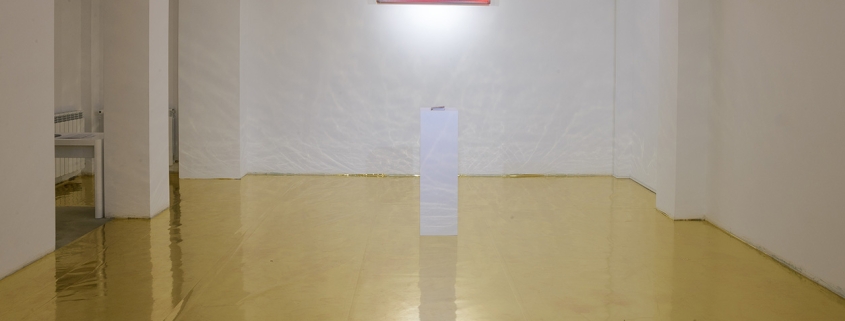FIRST AS FARCE,
THEN AS TRAGEDY
Dan Acostioaiei
Curator: Cristian Nae
STATEMENT
Dan Acostioaei’s newest solo show draws on the famous Marxist quotation ”first as tragedy, then as farce”, which dramatized major historical events according to the logic of repetition, and questions the relations of complicity and contrariety between the spectacle of contemporary art and leftist ideological and social engagement by means of a minimal dramaturgy.
The Marxist phrase, taken over by Slavoj Žižek and borrowed from Hegel’s philosophy of history, proposed a materialist reading of revolutions, informing at the same time on their possible failure. Its reversal ponders on the uncertain effects of critical discourse today. It also suggests the potential annihilation of subversive gestures such as irony, farce, carnivalesque and derision in the diffuse network of contemporary art. These attitudes may actually re-empower capital which is able to absorb the energy produced by those cracks in the neoliberal discourse.
Comprising artworks produced especially for this event, the exhibition proposes a tragi-comical scenography in which a collective performance unfolds, temporarily transforming both the physical space and the significance of the art gallery. Their spatial articulation self-critically and cynically uses the tension between leftist and neo-liberal discourses and speculates the language of Christian-orthodox ritual, associated with irrational thinking, dogmatism, conservatism and tradition.
For instance, the artist book produced by Dan Acostioaei (a prayer book for the art scene) distances itself ironically from the authority of the art institutions and historical narratives that have resulted in the fetishisation and sacralisation of the historical avant-gardes. The quote taken from the religion schoolbook, played on a cheap media display, simulates the information flow with a dissimulated ideological message in the Romanian public space and ridicules at the same time the extreme commercialisation of any form of protest, including dematerialized, performative and corporal art. Using the same code, one can decipher the gilding of the gallery floor, which suggests the transformation of the exhibition space into a three-dimensional religious icon. The text inscribed on the wall in the adjoining room in the manner of a decorative frieze reminding of the art nouveau style proposes a minimal ethic of the relations and transactions between the gallerists and the represented artists.
Ironically employing the language of both mass-media and mysticism, as well as commonplace objects endowed with new meanings, with an ambiguous liturgical significance, the exhibition aims at stirring a debate on multiple topics: the precarious condition of contemporary artists, some of their provincial dilemmas, which are nonetheless geographically indistinct, their ambiguous relation with commercial art galleries and the contribution of the modern network of producers, mediators and artistic agents to maintaining the hegemony of Western institutions, the bio-political aspects of religious discourse and their replication in the micro-public sphere of contemporary art.

